The Anaheim Ducks had a busy trade deadline. First, they traded Ondrej Kase to the Boston Bruins in return for a first-round pick, Axel Andersson and David Backes. Monday morning, they traded Derek Grant to the Philadelphia Flyers in exchange for center Kyle Criscuolo and a conditional fourth-round pick and sent Nick Ritchie to the Bruins for Danton Heinen.
Related: NHL’s 600-Goal Club
When all was said and done, the Ducks traded away six NHL players and two minor leaguers including Daniel Sprong. Anaheim didn’t have any major rentals to offer this season, but general manager Bob Murray managed to net draft capital and add cheap, young players who can improve the team’s speed and skill.
Derek
Grant Flies to Philly
Last week, I made a case for the Ducks to keep Grant. In addition to his production, management could lock down some consistency on their fourth line. However, I understand why they made the trade. Why focus on fourth-line consistency and depth scoring when you don’t have any primary scoring?
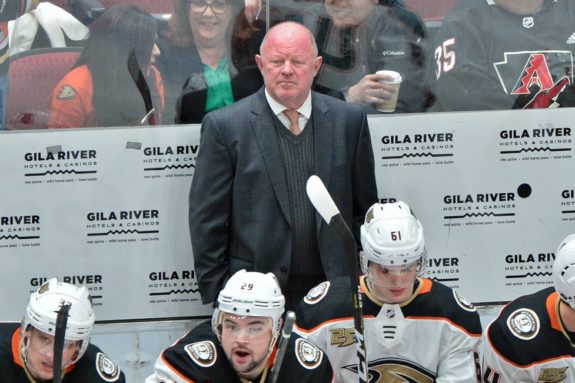
Grant was third on the team in goals with 14, playing on a league-minimum $700,000 per year deal. His production, contract, and pending unrestricted free agent status made him an attractive target.
Losing him will be another blow to the Ducks’ struggling penalty kill and removes a player who provided some scoring punch to a team that hasn’t had much.
The
Return
Did the Ducks get enough in return for Grant? The 27-year old Criscuolo is a career AHL player. He’s played only nine NHL games for the Buffalo Sabres, with zero points. He’s a depth player for the San Diego Gulls and will not be a factor on the Ducks.
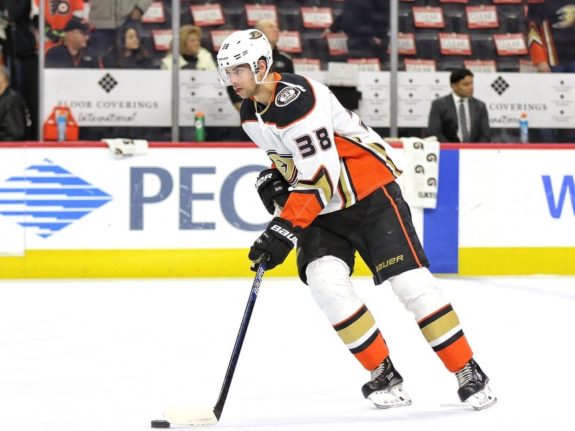
The more critical aspect of this trade is the conditional fourth-round pick that will be higher than the Flyers’ other 2020 fourth-round selection. Murray has been good at selecting NHL caliber players in the draft, but his best fourth-round pick was Sami Vatanen in 2009.
Since then, Murray’s only fourth-round pick to play in the NHL was Kevin Roy in 2012. With eight fourth-round picks since 2009, he hasn’t had a pick in that round in five drafts, suggesting he likes to trade them away. Time will tell how Murray came out of this trade after he makes his pick or trades it away, but for now, the more draft picks the better, to an extent.
Ducks
and Bruins Encore Trade
Ritchie has been expendable for a long time. He failed to live up to the hype of his No. 10 overall draft position and was given plenty of time to do it. He was perfect “hockey trade” bait, and it finally happened Monday when the Ducks traded him to Boston in exchange for Heinen.
In just over two-and-a-half full seasons in Boston, Heinen maxed out at 16 goals and 31 assists in 2017-18. Between then and 2018-19, he spent significant time playing alongside some of the Bruins’ best on the first and second lines and on the power play but was on the fourth line just as often.
Heinen can play on both wings, so he could skate on multiple lines within the Ducks’ ever-changing forward groupings. Compared to Ritchie, he’s faster and has better hands. He isn’t as physical, but he won’t earn nearly as many penalties. What’s the downside? Heinen tends to go on long scoreless droughts and for a team that desperately needs scoring, he’s not going to get it done.
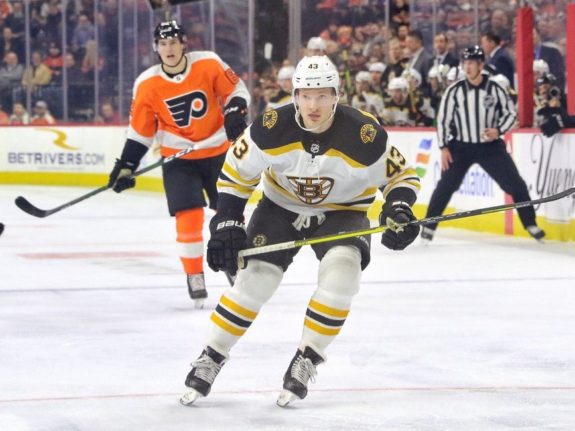
Is he better than Ritchie? It’s probably a push, but the change of scenery may help both players, and Heinen is already off to a great start, getting an assist in his first game Tuesday night.
Ducks Spring Sprong
to Capitals
Sprong had seemingly exhausted his chances with the Ducks. After he landed in the AHL out of training camp, he didn’t see NHL ice until Dec. 22. He scored his first goal and added his first assist of the season in his second game on Jan. 5 versus the Nashville Predators. He remained in the NHL for the next six games and didn’t contribute a point before the Ducks sent him back down.
Sprong was a polarizing figure. Fans salivated over his offensive skills, including a blazing and accurate shot. Unfortunately, his risky play and shaky defensive game kept him buried in the AHL.
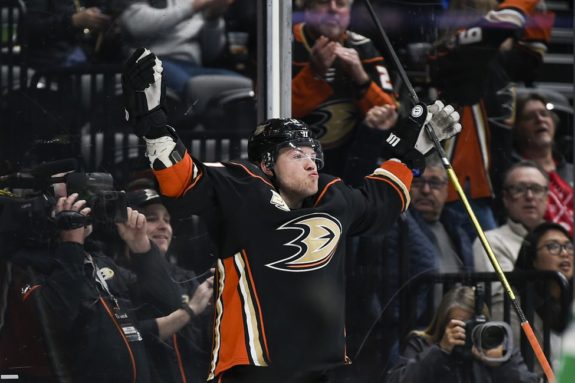
The Sprong experiment is now over after the Ducks traded him to the Washington Capitals for defenseman Christian Djoos. Djoos is still on the young side for a defenseman at 25 years old. The 2012 seventh-rounder has played 110 regular-season NHL games with his best season coming in 2017-18 when he contributed 14 points in 63 games.
Though Djoos regressed after that, he does have his name engraved on the Stanley Cup, winning with the Capitals in 2017-18 and playing 22 games in that run. That experience is valuable, and his seasoning could help young defenders like Josh Mahura and Jacob Larsson. The best-case scenario is for him to eventually take over Korbinian Holzer’s role as a bottom-pairing defender like he did Tuesday night.
Ducks Send Holzer to Predators
Holzer’s story was inspiring. The German-born defender finally had a full-time NHL gig playing the role of the sixth or seventh defenseman under Dallas Eakins, who had lots of experience coaching him.
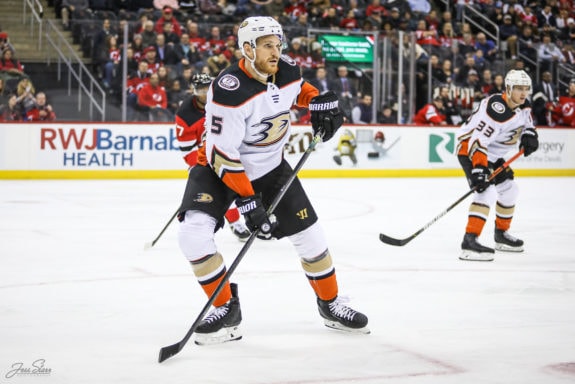
To say that Holzer was effective would be an overstatement, but he was a serviceable NHL defender at 31 years old. The Ducks’ return for Holzer came in the form of a 2022 sixth-round pick from the Predators and 32-year-old, left-shot defender Matt Irwin.
The draft pick is fine and Irwin is another body on defense. He’s played 22 games for the Predators this season, tallying two assists. If his name sounds familiar, his best season came in 2014-15 when he had 19 points for the San Jose Sharks. This trade was also more or less a push when it comes to NHL talent but the draft pick always helps.
Ducks Trade Shore to Blue Jackets
One of Monday’s later trades came when the Ducks traded Devin Shore to the Columbus Blue Jackets for 23-year-old Sonny Milano. Of all the deals the Ducks made this trade deadline, this one is the most exciting.
Shore has been a disappointment since joining the Ducks in last year’s Andrew Cogliano trade, spending a lot of time in the press box. Losing him isn’t devastating, but when you realize that he was the return in the deal that sent fan-favorite Cogliano to the Dallas Stars, it stings a little (not that Cogliano has done much in Dallas).
For a relatively low price, the Ducks acquired the 2014 No. 16 overall pick. In fact, he went six spots after Ritchie. He’s played fewer than half the number of NHL games that Ritchie played before the Ducks traded him, but Milano’s numbers are still trending upward.
Through 48 games this season, he’s four points away from his career-high of 22 points that he reached in 2017-18 in 55 games. Milano spent most of last season in the minors and out with an injury, so he has a lot left to prove to the Ducks.
He made a strong impression in his first game when he scored two goals, including the overtime winner to lift the Ducks over the Edmonton Oilers 4-3.
If Milano continues to perform this trade may become the steal of the deadline. In the worst-case scenario, he’s the next Sprong meaning he didn’t cost them much, and they can afford to trade him again.
Another
New Persson in Anaheim
The final trade the Ducks made on Monday sent ECHL goaltender Angus Redmond and a conditional 2022 seventh-round pick to the Oilers in exchange for Joel Persson. The pick only goes to Edmonton if Persson plays 25 games next season.
Persson is a 25-year-old Swedish defenseman who was undrafted but has shown some promise with the Bakersfield Condors. The undersized defenseman has 16 points in 27 AHL games this season.
Scouting reports paint Persson as a skilled skater and puck-mover who could contribute on the power play if he reaches the NHL. He needs to add some mass to his 5-foot-11 frame but could turn into a decent second or third offensive defenseman.
He’s also a right shot, which the Ducks are sorely lacking. Giving up an ECHL goaltender and potentially a late-round draft pick is surprisingly good for a defender that might one day contribute in the NHL.
The
Verdict
Considering what Murray had available to trade, he gets a passing grade for this trade deadline. Though some fans wanted him to leverage more valuable players like Adam Henrique or Josh Manson, that wasn’t realistic. If the Ducks are going to get back to being competitive as soon as possible, selling every one of value for as many assets as possible isn’t smart.
The NHL is the most competitive league in the world and learning how to play in it takes the help of veterans who have gone through the struggle. Without players like Henrique, Jakob Silfverberg and Manson to teach players like Trevor Zegras, Brayden Tracey and whoever else may come along, how to practice and play in the NHL, the Ducks would not be competitive for much longer.
Let’s call it a high B or low B plus. Murray made do without the big-name rental player that usually gets all the attention. He leveraged his cap space, netted three draft picks, including an additional first-rounder and took a chance on a few younger, quicker, more skilled yet unproven players. It isn’t glamorous, but it’s moving the team in the right direction.